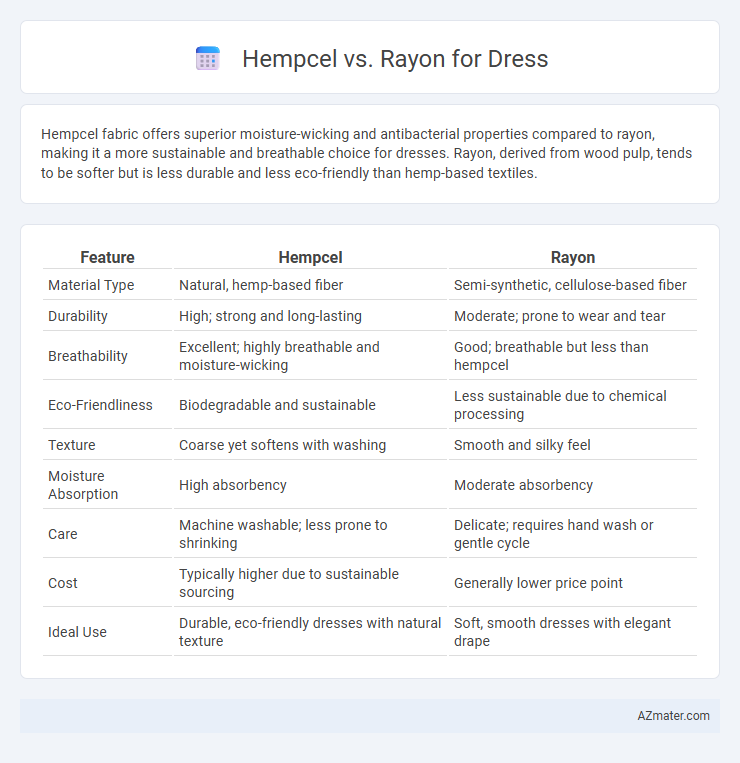Hempcel fabric offers superior moisture-wicking and antibacterial properties compared to rayon, making it a more sustainable and breathable choice for dresses. Rayon, derived from wood pulp, tends to be softer but is less durable and less eco-friendly than hemp-based textiles.
Table of Comparison
| Feature | Hempcel | Rayon |
|---|---|---|
| Material Type | Natural, hemp-based fiber | Semi-synthetic, cellulose-based fiber |
| Durability | High; strong and long-lasting | Moderate; prone to wear and tear |
| Breathability | Excellent; highly breathable and moisture-wicking | Good; breathable but less than hempcel |
| Eco-Friendliness | Biodegradable and sustainable | Less sustainable due to chemical processing |
| Texture | Coarse yet softens with washing | Smooth and silky feel |
| Moisture Absorption | High absorbency | Moderate absorbency |
| Care | Machine washable; less prone to shrinking | Delicate; requires hand wash or gentle cycle |
| Cost | Typically higher due to sustainable sourcing | Generally lower price point |
| Ideal Use | Durable, eco-friendly dresses with natural texture | Soft, smooth dresses with elegant drape |
Introduction to Hempcel and Rayon
Hempcel is an innovative fabric derived from hemp fibers known for its sustainability, breathability, and natural antimicrobial properties, making it an excellent choice for eco-conscious dress materials. Rayon, a semi-synthetic fiber made from regenerated cellulose, offers softness and a smooth texture, mimicking natural silk while being versatile in fabric production. Both Hempcel and Rayon present unique benefits for dresswear, with Hempcel emphasizing environmental sustainability and durability, while Rayon emphasizes softness and luster.
Fabric Origins: Hempcel vs Rayon
Hempcel fabric originates from hemp fibers derived from the stalks of the Cannabis sativa plant, known for their durability and eco-friendly properties. Rayon is a semi-synthetic fiber produced by chemically processing cellulose from wood pulp or cotton linters, often involving intensive manufacturing processes. The natural, sustainable source of Hempcel contrasts with Rayon's reliance on chemical treatments and less environmentally friendly raw materials.
Production Process Comparison
Hempcel fibers are derived through an eco-friendly mechanical process that separates hemp fibers with minimal chemical use, resulting in sustainable and biodegradable material. Rayon production involves chemically intensive processes, including the use of toxic solvents like carbon disulfide to dissolve cellulose from wood pulp, raising environmental concerns. The contrast in their production highlights Hempcel's advantage in reducing toxic chemical waste and energy consumption compared to the resource-heavy and pollutant-prone rayon manufacturing methods.
Sustainability and Environmental Impact
Hempcel fabric, derived from hemp fibers, offers superior sustainability compared to rayon as it is made from rapidly renewable hemp plants requiring minimal water, pesticides, and synthetic fertilizers, reducing environmental degradation. Rayon production involves chemically intensive processes and often relies on wood pulp from deforestation, contributing to habitat loss and higher carbon emissions. Choosing hemp-based dresses significantly lowers ecological footprints through biodegradability, reduced chemical use, and support for sustainable agriculture.
Texture, Feel, and Comfort
Hempcel fabric offers a coarse yet breathable texture that softens with washing, providing durable comfort ideal for casual dresses. Rayon has a smooth, silky feel that drapes elegantly, delivering a lightweight and cool sensation perfect for formal or summer dresses. Both materials balance comfort and style, but Hempcel excels in eco-friendly durability while Rayon prioritizes softness and fluidity.
Breathability and Moisture Management
Hempcel fabric offers superior breathability and moisture management compared to rayon, as its natural fibers facilitate better air circulation and wick moisture away from the skin efficiently. Rayon, while smooth and lightweight, tends to retain moisture longer, which can reduce comfort in warm or humid conditions. Choosing Hempcel for dresses enhances comfort by maintaining dryness and promoting ventilation, ideal for active or warm-weather wear.
Durability and Longevity
Hempcel fabric offers superior durability compared to rayon due to its natural hemp fibers, which are stronger and more resistant to wear and tear, making dresses crafted from Hempcel last longer under frequent use. Rayon, derived from regenerated cellulose, tends to weaken over time and is more susceptible to pilling and shrinkage, reducing the lifespan of garments. Choosing Hempcel for dresses ensures greater longevity and maintains fabric integrity through multiple washes and extended wear.
Style, Drape, and Aesthetic Appeal
Hempcel fabric offers a natural, textured appearance with excellent breathability, making dresses look effortlessly stylish and eco-friendly. Rayon provides a smooth, silky drape that elegantly flows over the body, enhancing the garment's aesthetic appeal with a luxurious sheen. While Hempcel emphasizes a rustic, organic vibe, Rayon is favored for its versatile, polished silhouette suitable for formal or casual dresses.
Care Instructions and Maintenance
Hempcel fabric offers superior durability and requires minimal maintenance, with care instructions recommending gentle washing in cold water and air drying to preserve its natural fibers. Rayon dresses demand more delicate handling, typically requiring hand washing or dry cleaning to prevent shrinking and maintain softness. Choosing Hempcel over Rayon ensures easier upkeep and longer-lasting garment quality due to its resilient, eco-friendly properties.
Which is Better for Dresses: Hempcel or Rayon?
Hempcel, made from hemp fibers, offers superior breathability, durability, and eco-friendliness compared to rayon, which is a semi-synthetic fiber derived from wood pulp. Rayon tends to have a softer, more fluid drape, making it ideal for lightweight, elegant dresses, while Hempcel provides a more structured, natural feel with excellent moisture-wicking properties. For sustainability and longevity, Hempcel is better suited, whereas rayon excels in achieving smooth, luxurious textures often desired in formal or flowing dress designs.

Infographic: Hempcel vs Rayon for Dress
 azmater.com
azmater.com